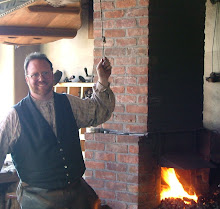This week, our Percheron draft horse Zeb was brought to Peleg Field's blacksmith shop for new shoes. I am a blacksmith I am not a farrier; for that expertise we call on Danny Conklin, a blacksmith and farrier. He has worked with Zeb and made his shoes for the last 12 years. Zeb and Danny work together like old friends, and visitors often remark about how calm Zeb is while getting new shoes fitted and nailed on. At one point Zeb seemed to be trying to take a nap.
 The first step is to remove the old shoes. Then his hooves are trimmed. Danny had already forged Zeb’s new shoes at his last visit to the blacksmith shop. The new shoes were heated in the forge and adjusted while hot to exactly fit each foot. Once the shoes are all well fitted they are nailed onto the horse's hooves. Not only does that not hurt, but the well fitted shoes protect the horse’s hooves from damage and excessive wear.
The first step is to remove the old shoes. Then his hooves are trimmed. Danny had already forged Zeb’s new shoes at his last visit to the blacksmith shop. The new shoes were heated in the forge and adjusted while hot to exactly fit each foot. Once the shoes are all well fitted they are nailed onto the horse's hooves. Not only does that not hurt, but the well fitted shoes protect the horse’s hooves from damage and excessive wear. 
 Shoeing was a daily task in general blacksmith shops in the 1840s. We have one horse at the Museum, so shoeing only happens about once every six to eight weeks. Dozens of visitors stayed at the shop throughout Zeb’s shoeing to watch. It is rewarding to present this part of the blacksmith’s trade to the public.
Shoeing was a daily task in general blacksmith shops in the 1840s. We have one horse at the Museum, so shoeing only happens about once every six to eight weeks. Dozens of visitors stayed at the shop throughout Zeb’s shoeing to watch. It is rewarding to present this part of the blacksmith’s trade to the public.
 The first step is to remove the old shoes. Then his hooves are trimmed. Danny had already forged Zeb’s new shoes at his last visit to the blacksmith shop. The new shoes were heated in the forge and adjusted while hot to exactly fit each foot. Once the shoes are all well fitted they are nailed onto the horse's hooves. Not only does that not hurt, but the well fitted shoes protect the horse’s hooves from damage and excessive wear.
The first step is to remove the old shoes. Then his hooves are trimmed. Danny had already forged Zeb’s new shoes at his last visit to the blacksmith shop. The new shoes were heated in the forge and adjusted while hot to exactly fit each foot. Once the shoes are all well fitted they are nailed onto the horse's hooves. Not only does that not hurt, but the well fitted shoes protect the horse’s hooves from damage and excessive wear. 
 Shoeing was a daily task in general blacksmith shops in the 1840s. We have one horse at the Museum, so shoeing only happens about once every six to eight weeks. Dozens of visitors stayed at the shop throughout Zeb’s shoeing to watch. It is rewarding to present this part of the blacksmith’s trade to the public.
Shoeing was a daily task in general blacksmith shops in the 1840s. We have one horse at the Museum, so shoeing only happens about once every six to eight weeks. Dozens of visitors stayed at the shop throughout Zeb’s shoeing to watch. It is rewarding to present this part of the blacksmith’s trade to the public.
How far into the hoof do the horses nerves start?
ReplyDelete